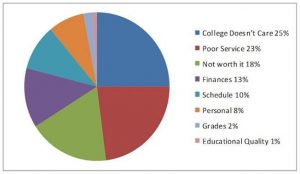Students today have so many options: if they are not engaged and valued in the academic community, they may go to another institution. To quote Sam Walton, “If you don’t take care of your customer, someone else will.” In fact, 23% of students will leave a college or transfer to another institution due to the perception of poor service. (Raisman, 2012)
Below is a statistical data demonstrated that one of the most frequent causes of attrition:

The expectation of immediate responsiveness was not around five years ago, and in the digital age, we now expect a response to a request immediately. Our students and their parents experience this type of service response daily, and are now expecting the world of higher education to offer the same type of immediate service response. Customer service in higher education is being often compared with services provided to customers from retailers like Amazon.com or the entertainment companies like Disney and Princess Cruises, as well as many other companies that now realize service to customers is the key to repeat business and good word of mouth.
The Obama administration has added to this endeavor by emphasizing that higher education must be mindful of the “value” that colleges and universities offer students and their families. Looking to ideals of “customer service” is a natural route for many in higher education, since one goal for many of us is improving the student experience and student satisfaction.
Based in any way on the outdated, antiquated, never-should-be-said-again expression, “the customer is always right.” The customer is not always right, but it is our job to make the situation right.
If the institution intends to provoke culture change with “the customer/student is always right,” then that tells that faculty and staff are always wrong. Who wants to buy into that? Instead, to try to create an empowering culture that allows and encourages people to go out of their way for the good of the customer. To demonstrate how to do that through training and supportive measures built into the high education program (s). Reward and praise the behaviors and results you want to see more often- it is amazing how fast and far that can go in a program that is about serving others!
Solutions
Keep the effort focused on the student and their needs, and on how delivery of services can help retention and graduation numbers. That can produce broad interest across the institution.
One approach is to work directly with individual departments on their points of service contact. Allow small successes with these departments to inform the “word on the street” about the training opportunities that are available on campus.
Address service basics, attitude, civility, history & traditions, assisting with difficult situations, and personal accountability. This comprehensive training program has allowed us the opportunity to set clear expectations and raise the service skills and awareness of our employees.
Sharing the history and traditions of our university is an excellent way to use training to create more of a culture and build institutional pride, which then shows in every service interaction.
“We aren’t a 4-star hotel, the customer isn’t always right.” This is true, and at most, 4-star hotels the customer is not always right either. Customers usually do not expect to have every whim catered to; the goal is usually to meet or exceed expectations. In higher education, it can be helpful to illustrate ways that we all work to enhance student satisfaction by meeting expectations. The question is what are students’ expectations and how should we work to meet or exceed them?
“Mandatory” is such a dreaded word in higher education, and that approach will set a program up to fail from the beginning. At FNU, employees are strongly encouraged to attend the service excellence trainings, and then the university rewards those who take advantage of the opportunity with a celebration and certificate when the training program is complete.
References
Seigle Peatman, Sarah. (2017) What Does Customer Service in Higher Education
Actually Look Like? – Retrieved from Academic Impressions [eNewsletter] at events@academic-impressions.com on February 26, 2019.



